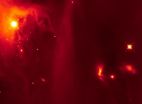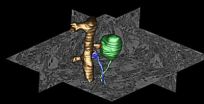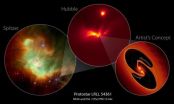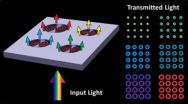(Press-News.org) New Haven, Conn.— A team of scientists anchored at Yale University has demonstrated a new, highly versatile approach for quickly assembling drug-like compounds, establishing a broad new route to drug discovery and medical treatment. They report their results in the journal Science on Feb 8.
Drug molecules interact with their targets, such as proteins or enzymes, by attaching to them in a way that neutralizes the target's undesirable effects in the body. This is sometimes called the "lock-and-key" method. The new approach offers scientists far greater control over the three-dimensional structure of a key class of molecular compounds, making it easier to fashion drug molecules that fit their targets in the right way.
"Now we've got a lot more control over the shape and orientation of this class of drug compounds, and this essentially gives us greater flexibility in creating effective drugs," said Jonathan Ellman, the Yale chemist who led the experiment.
The research reported in Science revolves around piperidines, a class of organic compounds widely used in pharmaceuticals, including the familiar drugs quinine, morphine, oxycodone, Plavix, Cialis, and Aricept. Piperidines are core structures, or scaffolds, upon which molecular fragments — parts of the drug molecule — can be displayed for binding to a drug's targets. The scientists have shown a way to generate different piperidine derivatives by varying acid strength.
"Our research allows us to make new piperidines easily," Ellman said. "The approach has biomedical relevance because the scaffold upon which the fragments are displayed is present in many of the most important drugs."
The research is being published without patent constraints and could be used by drug developers immediately, said Ellman, who is the Eugene Higgins Professor of Chemistry and professor of pharmacology. "I believe that this is the most effective approach for rapidly translating this work into new drugs," he said.
###
The paper is titled "Proton Donor Acidity Controls Selectivity in Nonaromatic Nitrogen Heterocycle Synthesis." Other authors are Simon Duttwyler, Shuming Chen, Michael K. Takase, Kenneth B. Wiberg, and Robert G. Bergman.
The National Institutes of Health, the U.S. Department of Energy, and the Swiss National Science Foundation provided support for this research.
For drug makers, new 3-D control opens wealth of options
2013-02-08
ELSE PRESS RELEASES FROM THIS DATE:
Hubble captures strobe flashes from a young star
2013-02-08
The cause of the fireworks seen in this Hubble image and video is hidden behind a dense disc and envelope of dust. However, astronomers think that the strobe effect is due to periodic interactions between two newly-formed stars that are gravitationally bound to each other.
These two stars drag material inwards from a surrounding disc of gas and dust. Astronomers propose that the light flashes seen in this video are due to this material suddenly being dumped onto the growing stars as they near one another in their orbits, unleashing a blast of radiation.
"The protostar ...
Hastings Center resources chart progress in debate over medical research with animals
2013-02-08
The scientific and ethical debate over the use of animals in medical research has raged for years, but perspectives are shifting, viewpoints are becoming more nuanced, and new initiatives are seeking alternatives to animal testing, according to a special report by The Hastings Center, "Animal Research Ethics: Evolving Views and Practices." The report is available on a new Web site, animalresearch.thehastingscenter.org, a hub of educational information that defines and interprets this changing landscape.
These resources are the outcome of a project on the ethics of medical ...
Excess protein linked to development of Parkinson's disease
2013-02-08
Researchers at the University of California, San Diego School of Medicine say overexpression of a protein called alpha-synuclein appears to disrupt vital recycling processes in neurons, starting with the terminal extensions of neurons and working its way back to the cells' center, with the potential consequence of progressive degeneration and eventual cell death.
The findings, published in the February 6, 2013 issue of the Journal of Neuroscience, have major implications for more fully understanding the causes and mechanisms of Parkinson's disease (PD), a neurodegenerative ...
NASA telescopes discover strobe-like flashes in a suspected binary protostar
2013-02-08
VIDEO:
This video, created from a sequence of images from the Hubble Space Telescope, shows a pulse of light emanating from the protostellar object LRLL 54361. Most if not all of...
Click here for more information.
Two of NASA's great observatories, the Spitzer and Hubble space telescopes, have teamed up to uncover a mysterious infant star that behaves like a strobe light.
Every 25.34 days, the object, designated LRLL 54361, unleashes a burst of light. Although a similar ...
The amazing amphibians and reptiles of the Philippine island Luzon
2013-02-08
A recent study of the amphibians and reptiles of Sierra Madre Mountain Range, northeastern Luzon, reveals a preliminary enumeration of more than 100 species that contribute to the unique biodiversity of the region. At present, the Luzon region's herpetological range stands at more than 150 species. Out of these, a total of 49 amphibian species have been documented, 44 of which are native and a remarkable 32 endemic. In the world of reptiles, Luzon can boast with 106 native species, 76 of which are unique to this region.
The catalogue published in the open access journal ...
Colon cancer exhibits a corresponding epigenetic pattern in mice and humans
2013-02-08
Tumourigenesis is driven by genetic alterations and by changes in the epigenome, for instance by the addition of methyl groups to cytosine bases in the DNA. A deeper understanding of the interaction between the genetic and epigenetic mechanisms is critical for the selection of tumour biomarkers and for the future development of therapies. Human tumour specimens and cell lines however contain a plethora of genetic and epigenetic changes, which complicate data analysis. In contrast, certain mouse tumour models contain only a single genetic mutation and allow the analysis ...
Study identifies liver gene that regulates cholesterol and fat blood levels
2013-02-08
Researchers have identified a microRNA liver gene, miR-27b, which regulates lipid (cholesterol or fat) levels in the blood. This regulator gene controls multiple genes involved in dyslipidemia—abnormal blood cholesterol levels that can contribute to heart disease. Study details published in the February issue of Hepatology, a journal of the American Association for the Study of Liver Diseases (AASLD), describe a new in silico approach to identify the significance of microRNAs in regulating disease-related gene pathways.
The Human Genome Project (HGP) was completed in ...
Boston College researchers' unique nanostructure produces novel 'plasmonic halos'
2013-02-08
CHESTNUT HILL, MA (February 7, 2013) – Using the geometric and material properties of a unique nanostructure, Boston College researchers have uncovered a novel photonic effect where surface plasmons interact with light to form "plasmonic halos" of selectable output color. The findings appear in the journal Nano Letters.
The novel nanostructure proved capable of manipulating electron waves known as surface plasmon polaritons, or SPPs, which were discovered in the 1950s but of late have garnered the attention of scientists for their potential applications in fields that ...
Specific warning signs of complications in colorectal surgical patients released
2013-02-08
Chicago (February 7, 2013): Colorectal surgical patients are often discharged from the hospital with vague guidance on how to recognize complications, but researchers at the Michael DeBakey Veterans Administration (VA) Medical Center and Baylor College of Medicine, Houston, aim to change that scenario. A health services research team convened a panel of surgical experts to develop a list of postoperative complication signs that should prompt colorectal surgical patients to call their surgeons or go to an emergency room. The study on the development of this early patient-centered ...
Dickkopf makes fountain of youth in the brain run dry
2013-02-08
The hippocampus – a structure of the brain whose shape resembles that of a seahorse – is also called the "gateway" to memory. This is where information is stored and retrieved. Its performance relies on new neurons being continually formed in the hippocampus over the entire lifetime. "However, in old age, production of new neurons dramatically decreases. This is considered to be among the causes of declining memory and learning ability", Prof. Dr. Ana Martin-Villalba, a neuroscientist, explains.
Martin-Villalba, who heads a research department at the German Cancer Research ...





